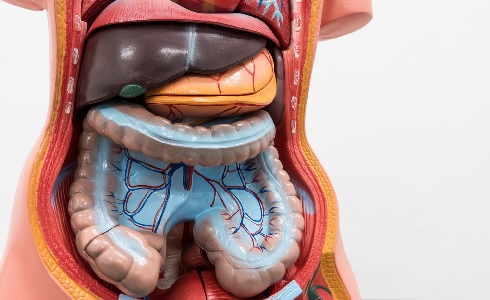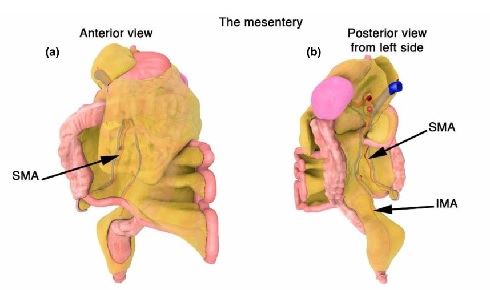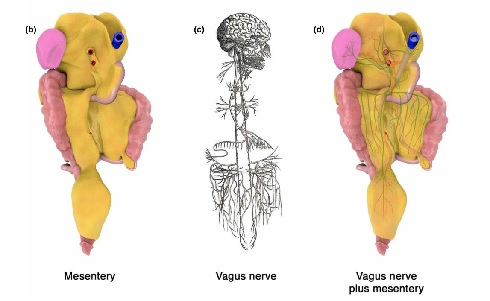The mysterious mesentery

Tom Ireland delves into a new paper on the mesentery, a connective membrane that was recently reclassified as an organ
28th September 2020
You might not be able to point it out on a diagram of the human body and you certainly can’t draw it: the mesentery is an intricately folded collection of tissues that joins the organs of the digestive system and is the newest structure in the human body to be classified as an organ.
As far back as 1899 anatomist Byron Robinson wrote that the definition of the mesentery was “as old as anatomy itself” but incorrect. Despite Leonardo da Vinci depicting it as one continuous structure, for hundreds of years anatomists saw it as a fragmented set of membranes formed from the peritoneum, the lining of the abdominal cavity. Robinson argued that unless this definition was abandoned “no advance in the knowledge of the mesentery can be expected”.
Over one hundred years later the sciences of anatomy, surgery and physiology have advanced significantly. So too has our understanding of the mesentery. In 2017, after repeated studies found that it was a continuous structure organising the digestive system and a high-profile article on the functions of the mesentery in The Lancet Gastroenterology/Hepatology[1], the tissue began to appear as the mesenteric organ in anatomical texts – including the famous Gray’s Anatomy – and was hailed by the press as the human body’s ‘79th organ’.
 Anterior and posterior representations of the mesentery, by Dara Walsh.
Anterior and posterior representations of the mesentery, by Dara Walsh. Abdominal infrastructure
Conventional anatomical teaching used to hold that there are multiple mesenteries and that the organs of the digestive system are anchored in place by these separate derivatives of the peritoneum. However, it is now recognised that the entire mesentery is one continuous structure and all abdominal digestive organs originate from it in the developing embryo. This close relationship is retained into adulthood where the mesentery is their primary connection to the body. An ever-increasing body of work is now showing that it is far more than simply connective tissue, with a key role in the inflammatory and immunological responses of the digestive organs too.
In early development the mesentery determines the position of the various elements of the digestive system. All abdominal digestive organs develop on or in the mesentery, and it provides the compressive forces required for the gut to loop and fold correctly. The organisation of abdominal vasculature is also based around the structure of the mesentery and the organ directly contributes to the development of each abdominal digestive organ, with the contents of the yolk sac distributed via the mesentery to developing organs. Cytokines produced by the mesentery help coordinate the migration of cells to the developing enteric nervous system.
The mesentery’s role as a kind of coordinator of the abdominal digestive organs continues into adulthood. Lymph nodes embedded in the mesentery are critically important in determining inflammatory and immunological activities in the intestinal mucosa. The adult human mesentery also contains adipose stem cells that are “highly proliferative, phagocytic and can drive inflammatory responses in the adjacent intestine,” according to Coffey et al[2].
Specific sections of the mesentery can also have highly specialised functions. The greater omentum, for example, once thought of as a veil of inert fatty tissue surrounding the stomach, is in fact now seen as a “vibrant immunological organ”[3] that helps with local control of infection, wound healing and tissue regeneration, and helps wall off regions of the abdomen from contamination.
Due to its intricate connection to the vagus nerve, Coffey and colleagues have begun to speculate that the mesentery may even execute higher-level functions, providing a link between our emotional state and our digestive system. “A growing body of literature links the vagus nerve with emotional responses,” Coffey explains. “We now know from our mesenteric work that if the vagus used the mesenteric platform, it could access many organs simultaneously, thus linking them with the brainstem or brain.” Coffey is clear to point out that this is still just an idea, but says that when people are asked to pinpoint where they ‘feel’ emotions most strongly, they localise it to between the abdomen and chest. “To date we have not been able to pinpoint the anatomical foundation for these real events.”
Digestive damage
Given the importance of its role in the coordination of the digestive system, the mesentery also plays a role in many digestive disorders. Encroachment of mesenteric fat into the intestines and excessive immunological activity in the mesentery are features of Crohn’s disease. The removal of mesenteric tissue “is emerging as an important element of the surgical treatment of inflammatory disorders,” writes Coffey.
Like the cartilage in the ears, the mesentery continues to expand and elongate throughout adult life, which can contribute to health problems such as hernias or bowel obstructions. It also supports the development of abnormal tissues such as tumours, heterotopic pancreata (pancreatic tissue growing separately from the main gland), splenunculi (small bits of spleen) and even ectopic pregnancies. Its function as a kind of framework tissue for organ growth has led to it being investigated as a biological scaffold for tissue and organ engineering. Experiments with animal models have demonstrated that when tissues are transplanted into the mesentery they remain viable and start to develop functions.
 The overlapping anatomies of the mesentery and the vagus nerve. Illustrations by Dara Walsh.
The overlapping anatomies of the mesentery and the vagus nerve. Illustrations by Dara Walsh. Is it an organ?
While the importance of this multifaceted connective structure is clear, whether to define it as an organ or not really depends on how you define an organ. Writing in Discover magazine[4] after the mesentery was widely hailed as ‘the body’s 79th organ’, Carl Engelking was unable to find any definitive definition of an organ, even after consulting several anatomists and historic texts, nor was he able to find a definitive source determining that there were 78 organs before.
Engelking settled on a modern definition that states an organ is a structure that is “composed of [at least] two tissues, is self-contained and performs a specific function”. Some scientists argue that an organ must provide a ‘vital’ function, while looser definitions allow it to mean any unified structure with a specific function, meaning it could include structures such as teeth or nipples.
Physical linkage of body components, enabling the transport or communication between multiple tissues, often does not seem to meet the requirements for designation as an organ. However, to see the mesentery as merely a connective system is to ignore its key functions related to the development and possibly control of digestive system organs. The mesentery is also structurally independent, with its own arterial inflow and venous drainage, representing a substantive proportion of cardiac output. More than 50 cytokines are produced in the mesentery, plus a huge range of enzymes, although it is still not yet understood whether these serve specialised or general functions, or both. “The main objection to the idea of the mesentery as an organ relates to its function, and whether that can be described as vital or special,” writes Coffey.
Biological circuit board
The question of whether the mesentery is an organ or not is really a matter of semantics rather than anatomy. However, reclassification of a tissue as an organ is a recognition of its wide-ranging and fundamental role, and hopefully means it will not be overlooked in future studies of digestion and development or in clinical practice. “It can be argued that adherence to the standard definition of the mesentery has impeded not only mesenteric science, but also our understanding of human biology in general,” writes Coffey. “The mesentery can be compared to a biological circuit board by which digestive organs are integrated in the body. Unless we understand the mesentery, we cannot hope to have a complete understanding of the mechanism by which the human body works.”
A fuller understanding of the role of the mesentery has already improved clinical practice and surgical procedures related to the digestive system. The mesentery is not unique to humans either – mesenteric continuity and direct connectivity with abdominal digestive organs are conserved across species of the animal kingdom, although mesenteric shape varies between species. Similar findings are being discovered in relation to a potential thoracic mesentery that encases and connects the lungs and heart. “If future studies of any digestive organ are to be conducted in the correct biological context, this should be done with reference to the region of mesentery with which the organ is connected,” writes Coffey.
Tom Ireland MRSB is editor of The Biologist. This article is based on a review of the mesentery recently published by Professor Calvin Coffey and colleagues in a special anniversary issue of Emerging Topics in Life Sciences.
1) Coffey, J. C. & O’Leary, D. P. The mesentery: structure, function, and role in disease. Lancet Gastroenterol. Hepatol. 1(3), 238–247 (2016).
2) Coffey, J. C. et al. Mesentery – a ‘new’ organ. Emerg. Top. Life Sci. 4(1) (2020).
3) Wang, A. et al. The greater omentum – a vibrant and enigmatic immunologic organ involved in injury and infection resolution. SHOCK 53(4) 384–390 (2020).
4) Engelking, C. What is an organ? Discover, 7 January 2017.
This article is based on a new review of the mesentery by Professor Calvin Coffey and colleagues, which appears in a special issue of Emerging Topics in Life Sciences. The issue celebrates 10 new fields or topics in life science as part of the RSB’s 10th anniversary year.


